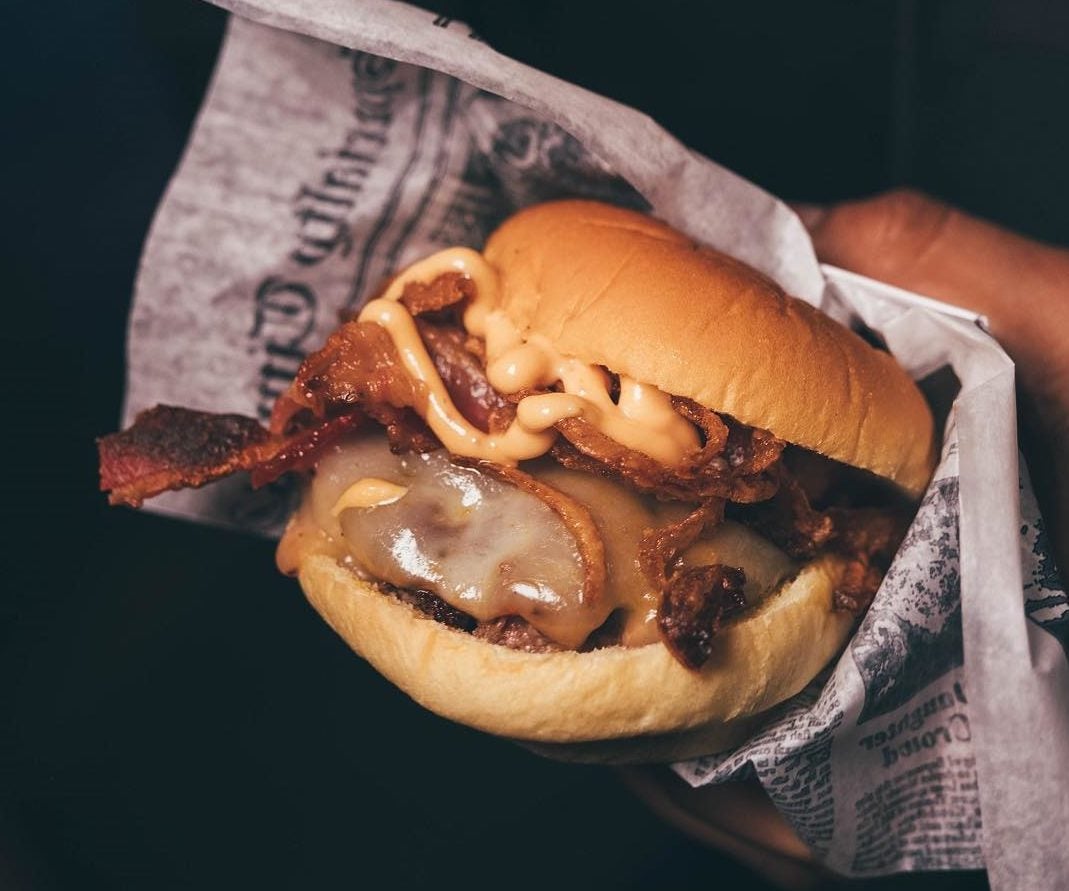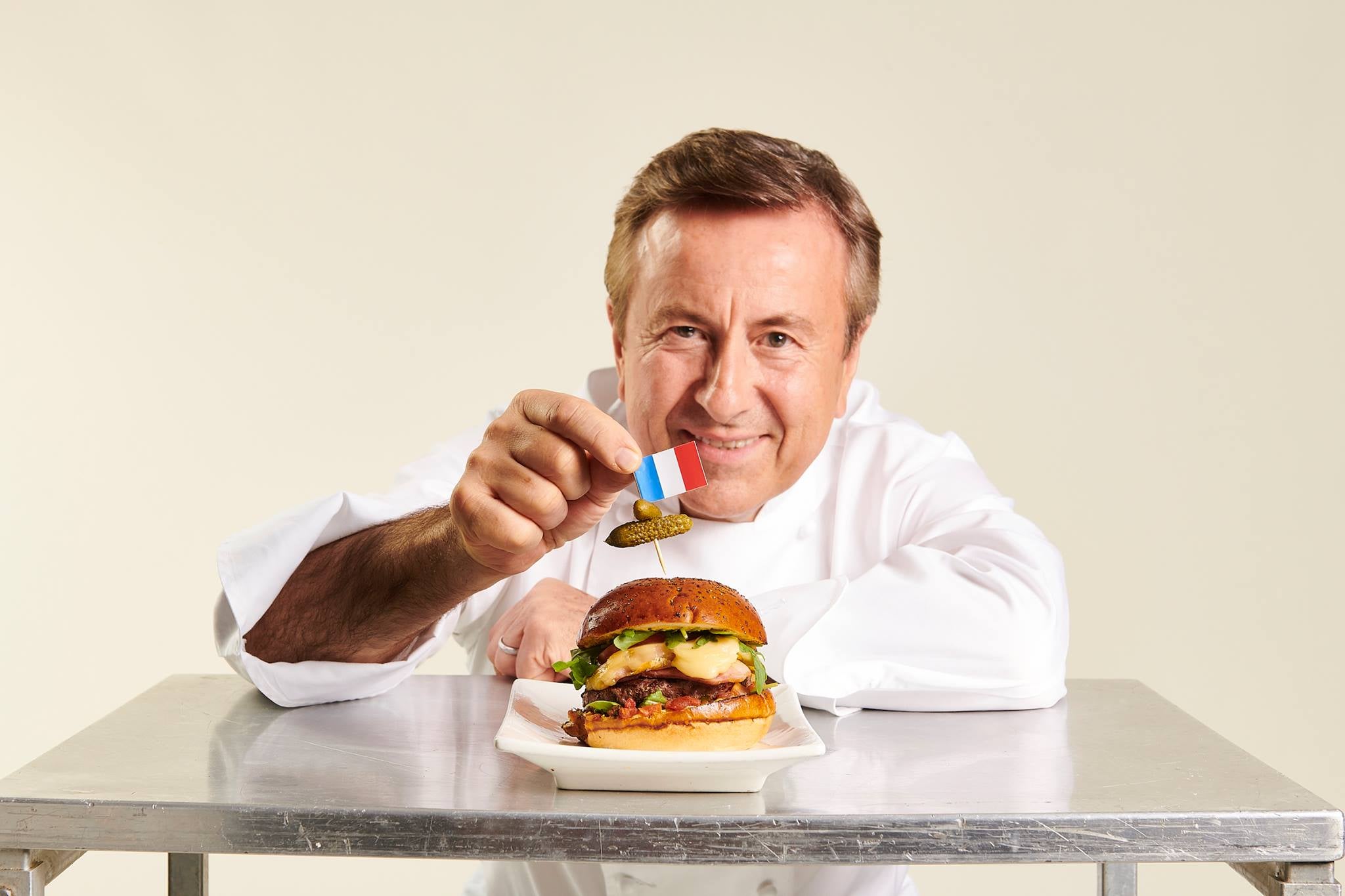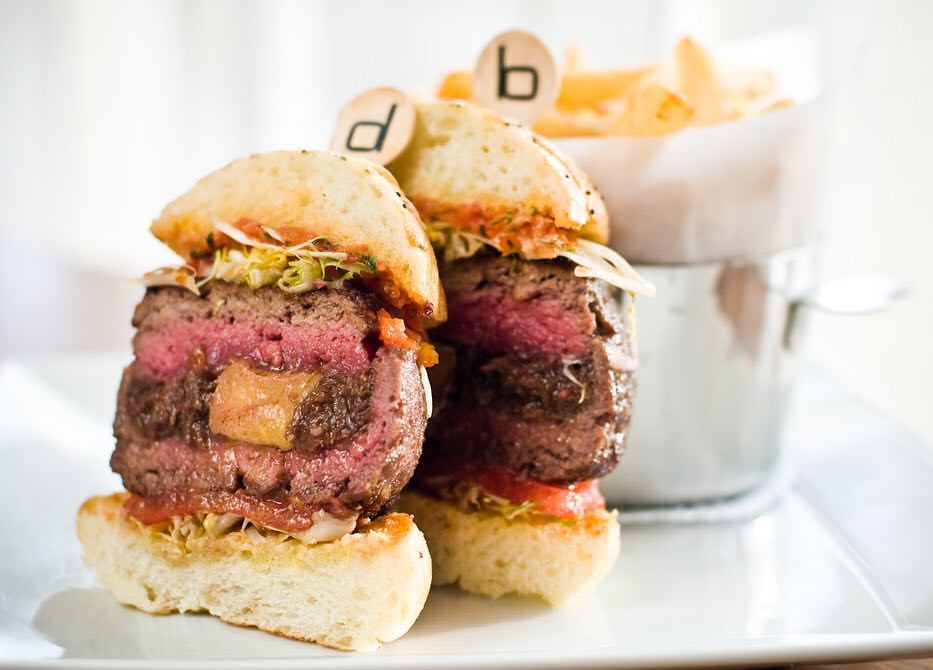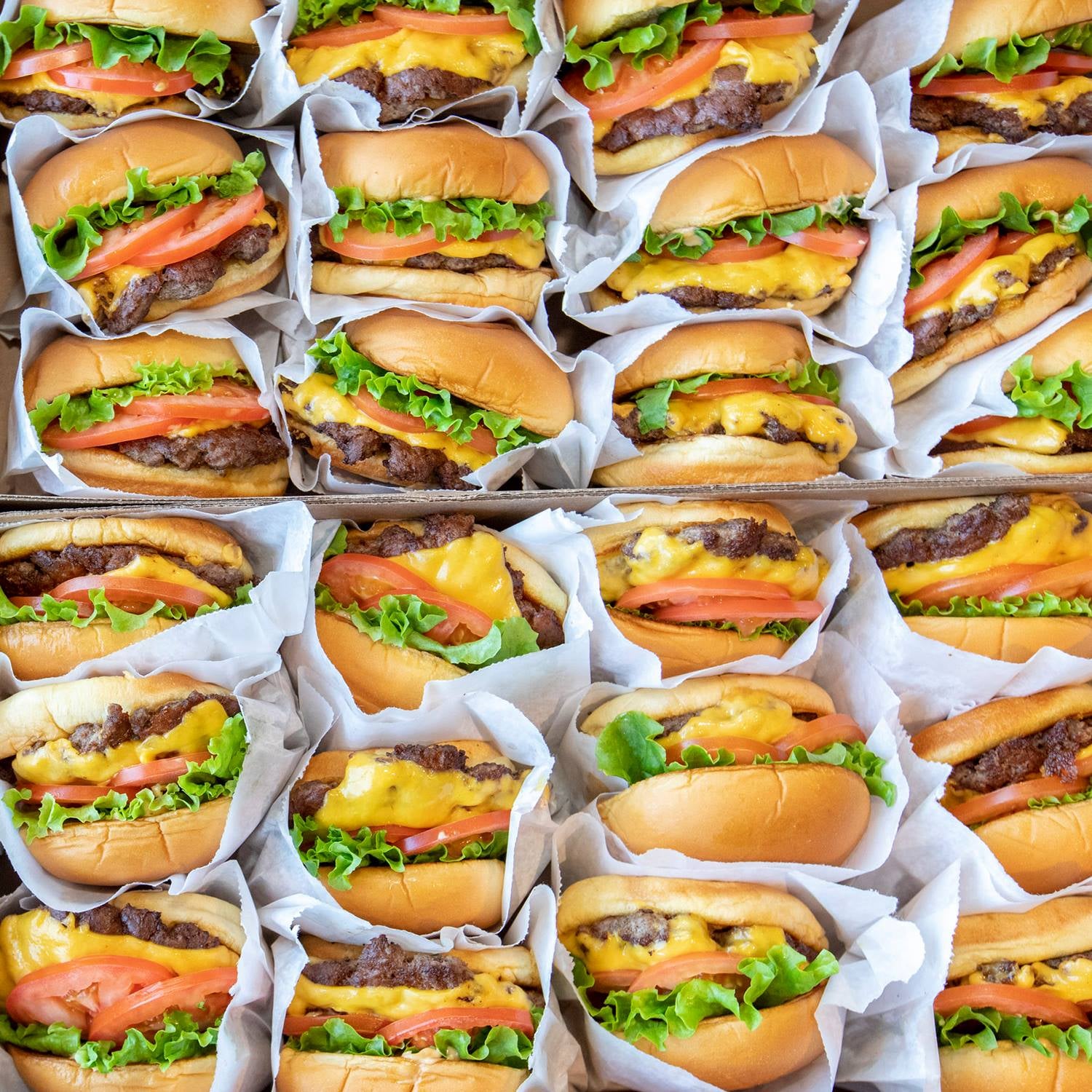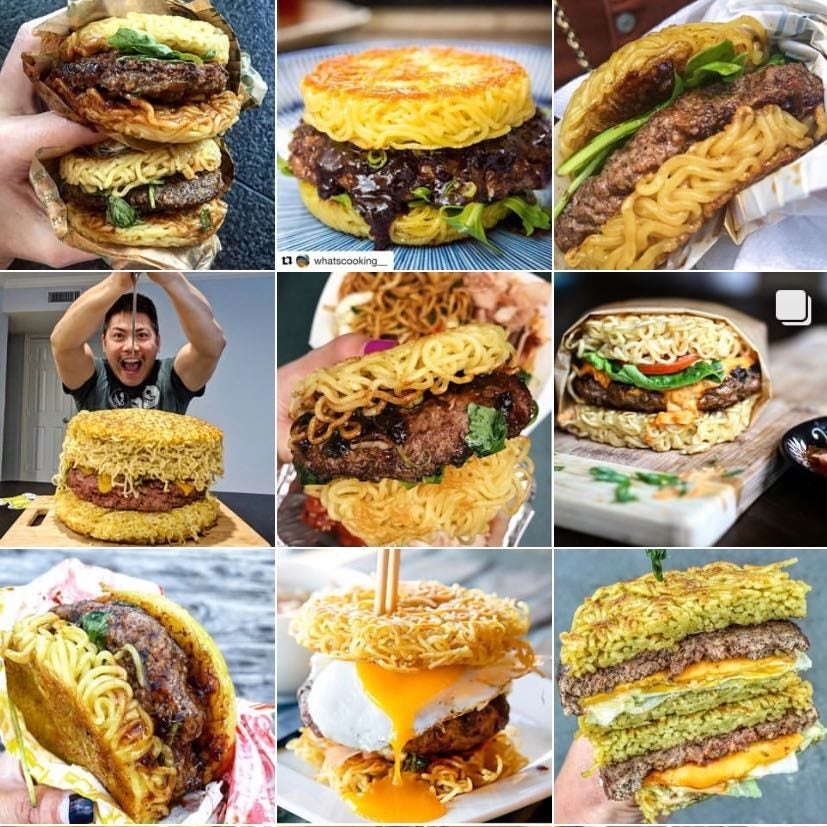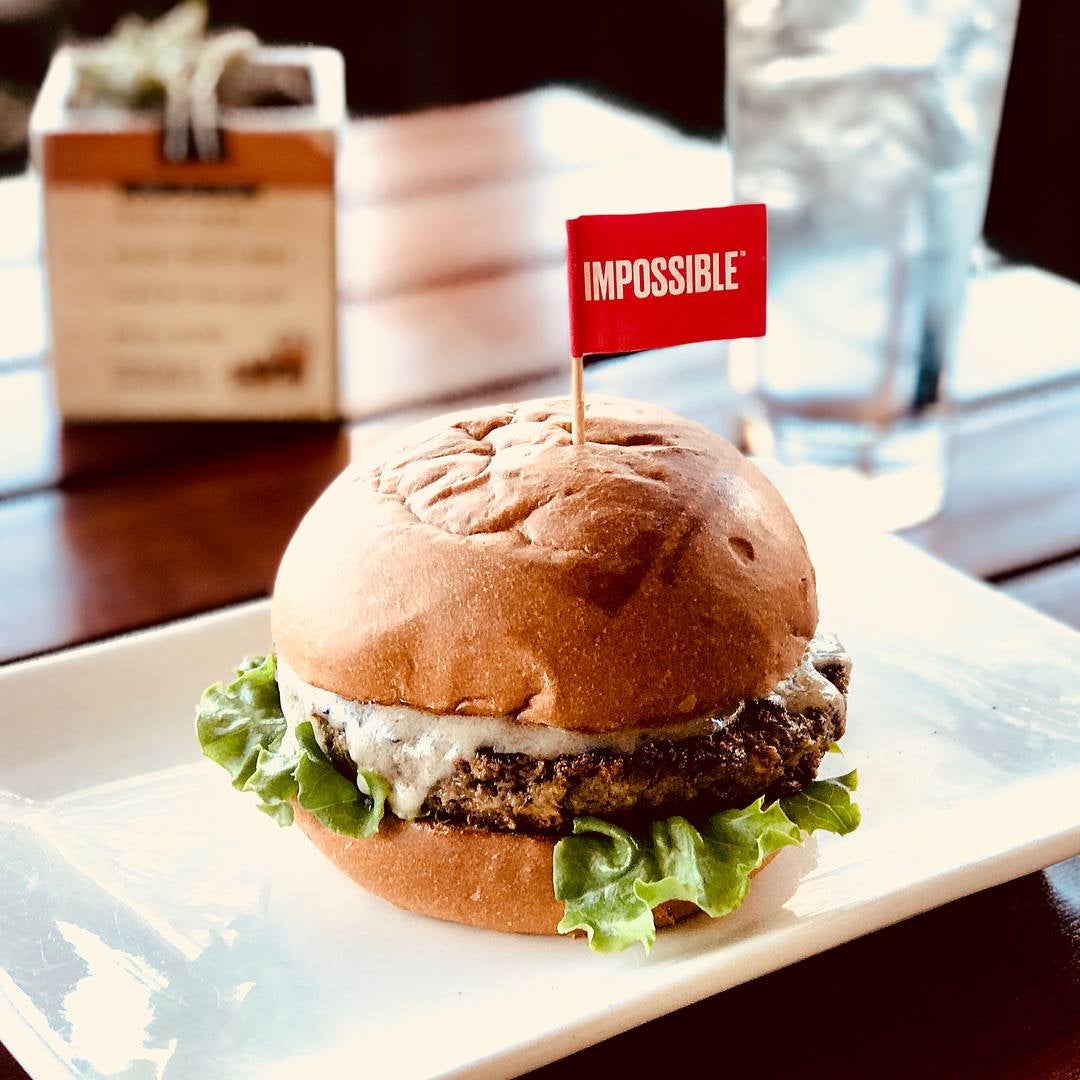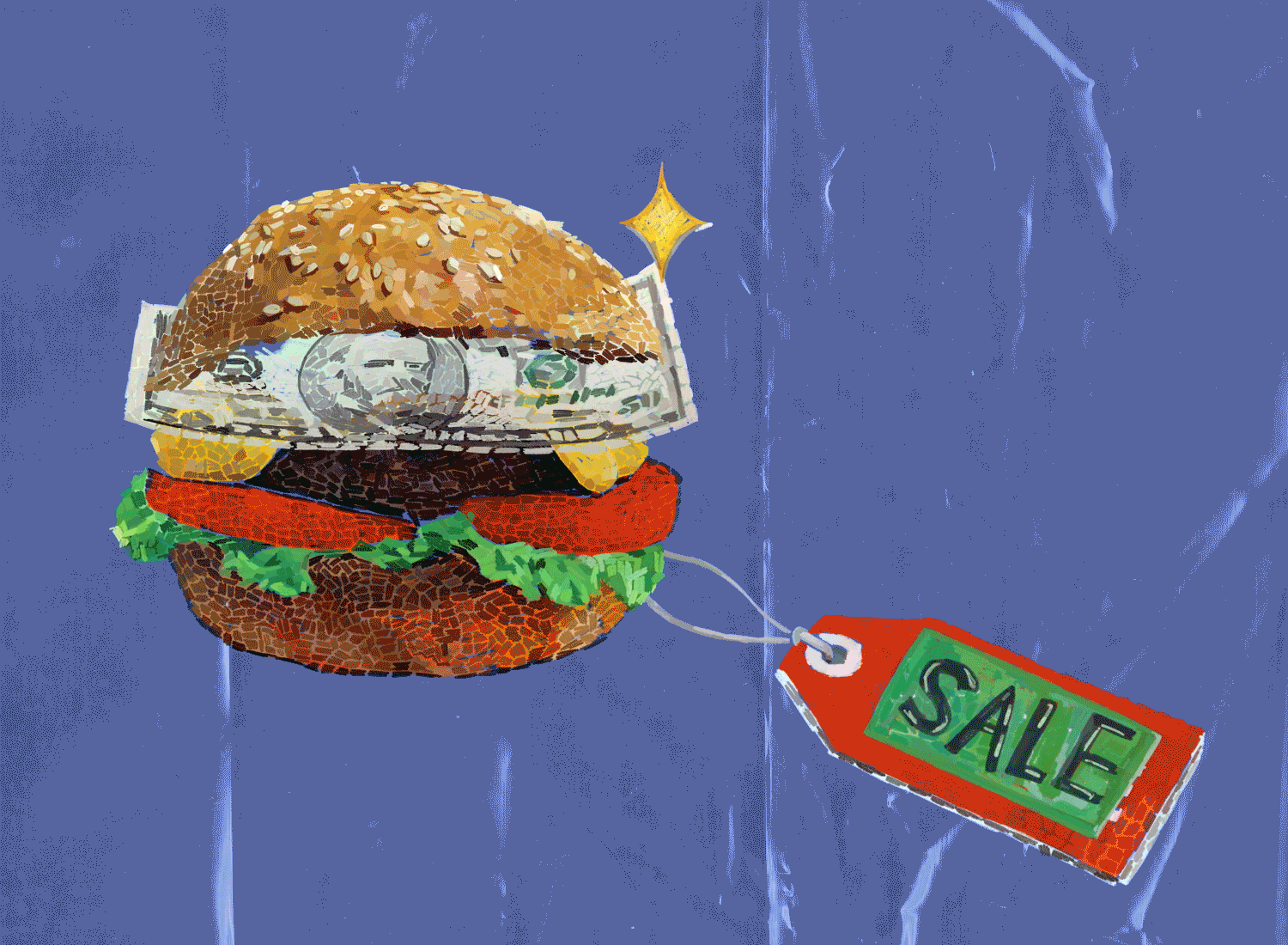
Hamburgers, with secretive beef blends, over-the-top toppings, and outrageous prices, used to be the celebrated calling card for any respectable chef. Then the histrionics of the patty became a punch line.
“I can smell the burgers,” said one man to another as they stood in the roped-off line leading to the escalator that would carry them to the New York Wine & Food Festival’s 11th annual Burger Bash. Behind them, a crowd had formed, a daisy chain of well-fed-looking men and women. Bros, expansive and confident, talked about infrared grills and basketball. Someone claimed to have spotted James Franco, but the sighting couldn’t be confirmed. Over the course of 30 minutes, the line continued to grow, filling the length of the 75,000-square-foot ferry terminal, until finally it began to move slowly but irrevocably forward. Any comparisons to cows plodding along a slaughterhouse chute went unarticulated.
At the top of the elevator, the crowd dispersed onto a huge rooftop. It was lined with white-tented booths; at its center, there was a DJ on a stage, pulsating ecstatically to his own music.
And there was the smell. It wasn’t the smell of beef sizzling on smoking metal. It was strong and sharp, but also ambiguous and hard to pinpoint; it suggested a wet dog that had rolled in something burned and rotten and sprinkled with fish sauce. Its exact origin was unclear; it was noticeable in the vicinity of the port-a-johns but not of them, and wafted over the pier in intermittent gusts, as though some malignant night phantom was trying to clear its throat.
But the smell—perhaps more accurately a stench—was not a deterrent to the crowd, which streamed toward the tents, alighting at each one to snatch slider-sized hamburgers from little bamboo plates. There were burgers jacked with Urbani truffles, burgers layered with American cheese and onion jam and a special sauce of indeterminate lineage, burgers wearing toupees of frizzled onions, burgers made from Pat LaFrieda’s dry-aged beef brisket and accessorized with mozzarella, spicy mayo, and pepperoncini relish.
Ground beef was everywhere, except for the cauliflower-crust pizza booth, which sat awkwardly and lonesomely amidst the revelry like a pastor at an orgy. A few people stood around it, trying to decode its purpose, until they were gruffly ordered out of the way by a ruthless-looking blonde woman who stood, human-shield-like, before a small entourage surrounding a beaming Rachael Ray.
In the middle of it all there were the Burger Bash judges, separated by a white picket fence from the crowd, which congealed around its perimeter with phones in hand, snapping pictures of Food Network eminences Andrew Zimmern and Geoffrey Zakarian and Hollywood’s own Neil Patrick Harris and Neil Patrick Harris’s husband. They sat behind a table and tasted the burgers, which numbered over 30. The music seemed to grow louder; the smell persisted. The midtown Manhattan skyline loomed over the rooftop, making everything seem very small.
If you want to blame someone for all of this, for the tents and the little bamboo plates and the long lines and the more overarching tendency of chefs and civilians alike to frame burgers as fetish objects, then blame Daniel Boulud. In 2001, the part of 2001 when the towers hadn’t yet come down, the great French chef made a hamburger unlike any that had been seen before. It was wrought of ground sirloin stuffed with red-wine-braised short rib and foie gras, layered with Dijon mustard, tomato compote, curly chicory, more tomato, slices of red onion, and grated horseradish, and then topped with a potato bun finished with cheddar and onion seed.
Christened the DB burger, it premiered at Boulud’s DB Bistro Moderne and immediately became a draw. Everything about it was rococo, from its ingredients to its height to its $27 price tag, the latter of which earned it the Guinness world record for most expensive hamburger. It was less hamburger than hyperbole, an unassuming American workhorse turned into a diesel-powered unicorn. The DB burger wasn’t the first fancy burger; that distinction is held by the 21 Club, which in 1950 debuted a patty cooked in duck fat and seasoned with fennel seed, and then had the gall to charge $2.75 for it (at the time, most burgers cost a nickel or dime). But the DB burger was a different beast entirely, and also one of a different era.
“When [Boulud] came out with that burger, it gave everyone license,” says Nick Solares, a contributor at erstwhile Serious Eats site A Hamburger Today. “It gave credibility to the notion of a chef actually making a hamburger.”
It also made people remember things they’d forgotten during the long, terrible reign of McDonald’s and Burger King—things like fresh ground beef, for example. In the DB burger’s wake, other luxury burgers began to appear around the country. In New York, the Old Homestead steakhouse created a rebuttal to the DB in the form of a $43 20-ounce burger made from Kobe beef, an exquisitely marbled (and expensive) strain of Japanese Wagyu beef procured from cattle plied with beer and regular massages until they are slaughtered.
Other notable, if not quite as transparently ridiculous, versions could be found in New York at Nice Matin, whose so-called five-napkin burger launched the 5 Napkin Burger chain; the Spotted Pig, where the patty came topped with Roquefort; Burger & Barrel, which opened the year after its chef, Josh Capon, won the 2009 Burger Bash; and the Minetta Tavern, whose $26 Black Label burger—made from a proprietary Pat LaFrieda blend of brisket, chuck, strip steak, rib eye, and dry-aged beef—immediately sailed straight into the annals of burger legend. And then, of course, there was Shake Shack, which began life in 2001 as a cart in Madison Square Park. In 2004, Danny Meyer expanded the cart into a kiosk, and the lines soon grew to such epic proportions that someone created a Shake Shack Lunch Wait Time graph.
Like the Black Label, many of these burgers used beef blends from Pat LaFrieda, a wholesale meat supplier whose then-revolutionary idea to turn dry-aged beef into a burger led New York magazine to dub him the Magician of Meat. Once people began paying attention to the pedigree of a patty—the use of whole muscle (no trimmings), the meat-to-fat ratio, the short-rib-shoulder-brisket, and chuck blend—this level of discernment began to trickle down to the provenance of buns and condiments, a shift that was aided by the concurrent farm-to-table movement. Even against the backdrop of the recession, people were still willing to pay more for the privilege of eating a “better” burger, and its bulletproof popularity arguably gave high-end chefs permission to start putting their names on all sorts of high-low endeavors, from tater tots to fast-casual chains.
If chefs began to see the hamburger as a blank canvas, that’s because it always has been: From its beginnings in the early part of the 20th century, we’ve piled it with representation and symbolism. It’s been everything from a talisman of good ol’ American innovation to an emblem of blandly evil corporate conformity to a vessel of globally proportioned environmental catastrophe. As such, it is ripe for eternal reinvention.
“The hamburger has a profundity to it that no other food has. If you’re an American, it’s our national dish,” Solares says. “You have this object that defines us, so whatever form that takes, it’s hard for me to argue against it. It’s as much an expression of the zeitgeist as it is an expression of good taste.”
By about 2010, the fancy burger had become all but ubiquitous, so thoroughly fetishized and aestheticized that its latter-day accoutrements veered perilously close to punch line territory. Of course every restaurant with a bar had a burger that attempted to distinguish itself from the rest, whether it came clothed in raclette, caramelized onions, and tomato aioli, à la New York’s Bowery Meat Company, or plopped on a biscuit and piled with pimento cheese, bacon jam, and an egg, à la Nashville’s Biscuit Love. Of course, those burgers were advertised by their parts rather than the sum of them: the grass-fed beef, the brioche bun, the house-made pickles, the special blend from LaFrieda or DeBragga, another purveyor of bespoke cow parts. Depending on how you looked at it, the burger had reached its apotheosis or nadir.
And then Instagram came along, and most certainly not to the rescue. If you want an idea of its impact on hamburgers, just search for #macandcheeseburger or #ramenburger or #rainbowburger.
But if Instagram encourages and rewards dumb food stunts, it has also had the effect of separating the pretenders from the innovators. Yes, the DB burger could be seen as one of the original stunt burgers, but “it was designed for shock value,” points out George Motz, a filmmaker, author, and TV host who has styled himself as America’s hamburger expert. And where Boulud, whom Motz describes as “the progenitor of a new awareness about hamburgers,” was upfront about his intentions, “some people won’t admit they’re making a burger for shock value,” Motz says. And that’s where the trouble comes in.
“We’ve created a monster,” he says. “I have people I would like to give an intervention. I’ve unfollowed them all.”
Interestingly, Instagram’s ascendance has dovetailed with the gradual decline of the burger frenzy; according to Google Trends, “boutique burger” peaked in December 2008, had a second spike in February 2011, and then declined precipitously. After its founding in 2009, the gourmet burger chain Umami Burger became so popular that its owner, Adam Fleischman, told The New Yorker that “it has the potential to be a McDonald’s.” That didn’t quite happen. But recently, three of the five results for a Google News search for “Umami Burger” were stories about the Impossible Burger, the “bleeding” plant-based burger that has enjoyed a dizzying growth trajectory since Silicon Valley gave birth to it in 2016.
This is not, of course, to suggest that people no longer enjoy hamburgers; Shake Shack, to use yet another metric, still has almost 200 locations across the globe. And even if Umami Burger, which was founded in 2009, keeps shuttering storefronts, other so-called better-burger chains, like Five Guys and Smashburger, continue to flourish.
And if every trend is followed by a backlash to that trend, the reaction to the fancy burger has come in the form of a resurgence of the classic American thin-patty smash burger; for spectacularly successful examples, see the hit Los Angeles pop-up Burgers Never Say Die or the General Muir in Atlanta. These rebukes to the fancy burger aren’t pretty, says Motz: “They are brown on brown, but people are building them to look better.” The trick to making them more photogenic, he adds, is “the double: When you build a double smash burger, it’s taller and there’s more cheese.”
If the thin-patty smash embraces the essential, Instagram-unfriendly brownness of the classic hamburger, it also allows certain chefs to make good on the promise of sustainability that so many of those fancy restaurant burgers peddled (to varying degrees of believability) in the form of grass-fed, thoughtfully sourced beef. “If you’re using decent stuff, you can’t really afford to serve more than two ounces of it and have it still be cheap,” says Chris Kronner. “[The smashed patty] returns it to this realm of accessibility for people who otherwise may not be able to eat at your restaurant.”
Kronner would know: As the chef-owner of Kronnerburger, the erstwhile Bay Area burger pop-up turned restaurant, he made one of the best hamburgers in Northern California, a classic American number that also happened to be built from local, sustainable meat. Kronner is so serious about more responsible sourcing that his 2018 cookbook, A Burger to Believe In, includes an entire section about the environmental problems associated with beef. It is likely the only cookbook, about burgers or otherwise, in which you will find a statistic about livestock methane emissions.
As such, Kronner understands the divide between the values people say they want to buy into versus what they’re actually willing to pay for; it’s why he charged $15 for his burger instead of $28, which is what it should have cost. Most people “just assume that all burgers are equal,” he says. “They have no understanding of what goes into it or what it takes to do something that’s actually different where you’re utilizing the best product you can.”
“We’ve created a monster. I have people I would like to give an intervention. I’ve unfollowed them all.”
Kronner closed Kronnerburger following a fire earlier in 2018; although he plans to reopen it, he needs a location where there will be enough foot traffic to support a $15 hamburger. Flipping through his cookbook, it’s hard not to be struck by the vast gulf separating what Kronner does from what the Burger Bash does; for one thing, there’s an entire chapter devoted to salads.
Putting aside the obvious about the New York City Burger Bash—its celebration of mindless consumption, its Barnum-esque framing of the hamburger as a big-tent spectacle—perhaps what’s most perplexing about it is that in blowing the hamburger up to tumescent proportions, it more or less erases it. It takes something that is the essence of simplicity—as Kronner says, a burger is just “a thin little piece of gray meat and taupe-colored bread”—and complicates it needlessly. Instead of looking forward to a potential future of truly better burgers that have any prayer of being marginally better for the planet, it looks backward.
Which, not incidentally, doesn’t put it out of sync with the rest of the world where the better-burger trend is concerned. “I don’t think it’s died at all; it’s constantly growing,” says Motz. “It’s all over the world now.” He’s regularly asked to consult with would-be burger entrepreneurs from Paris to Tokyo. “I do a lot of work in Brazil now, because Brazil has gone absolutely burger bonkers,” he says. He’s been asked to go there later this year. It’ll be his fourth trip in two years.
